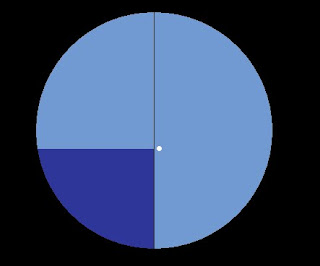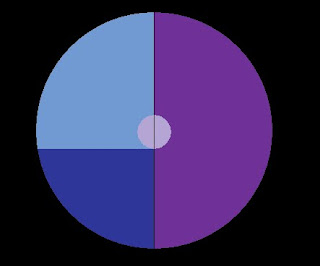Continuing with the basic introduction to celestial navigation, we now look at how we're going to actually use the sextant to determine the angle of the celestial object above the horizon. I've made a number of illustrations in MS Paint to illustrate what you will see through the sextant telescope. This was fairly simple. I have not, however, created corresponding illustrations of the sextant itself, either as a whole, or illustrating reading the limb or micrometer drum. I did attempt to render such illustrations in Paint, but doing so proved beyond my skill level. Hopefully their absence will not prove a stumbling block.
For this lesson I will assume that we are using a sextant with a traditional split-horizon mirror, but the principles are the same with a whole-horizon mirror also.
When you begin a round of sextant sights, you must first determine the amount of intrinsic error the alignment of the index mirror will instill into your sights. For a good metal sextant you might perform this step once every several days; for a plastic sextant you'll want to do this before and after every set of sights.
Set your sextant index arm to 0° 00.0'. Then look at the horizon. You will see something like this:
Now, adjust the index arm until the two images come together like this:
Now look at your index arm, and micrometer drum if your sextant has one. Unless your sextant is perfectly aligned, you will now read some number larger than 0° 00.0', either "on" the sextant arc between 0° and 90° or 120° or whatever number your sextant goes to, or else "off" the sextant arc beyond zero in the other direction. Which side this Instrument Error is on, you are going to correct your Height Shot (Hs) of the celestial object in the opposite direction. Think of it being like a jacket; if it's on, take it off, and if it's off, put it on. This opposite value of the Instrument Error is called the Instrument Correction, or IC. Write this number down, you'll be using it in all of your calculations later.
Now, move the index arm out toward the middle of the arc, somewhere around 40° is fine. Now looking at the horizon, on the index side of the mirror we see only sky:
Now, the sun has set and civil twilight has ended. We have precomputed that the star Capella bears about 043° True at an altitude of about 52° above the horizon. We dial 52° into the sextant index arm and aim the sextant toward the northeast horizon. And, by the miracles of astronomy and arithmetic, we find in our sextant telescope this:
Which is pretty darned impressive, considering.
You now, using the micrometer drum, bring Capella down until it just barely touches the horizon:
And to ensure that you are holding your sextant exactly vertical, you rock it back and forth so that the image of Capella also rocks back and forth. You want to measure the angle at the exact moment (very exact, remember four seconds of time is one nautical mile) that Capella barely kisses the horizon in lowest portion of the rockering.
That's all there is to taking a star sight with a sextant. Bring the star down to the horizon, mark the time, write the time down in your notebook, read the angle you shot off of the sextant limb and micrometer drum and then write those down next to the time. That's it.
The sun is mostly the same, with two exceptions. First, we have to use filters so that staring at the sun through a telescope doesn't burn out our retinas. In this case, the filter has made the sun appear purple.
Using the micrometer drum, bring the sun down so that the very bottom of the disk of the sun, called the Lower Limb, just touches the horizon. I haven't drawn it, but rock the sun just like you did with Capella. Because the sun is very bright, you will usually get a "ghost" image of the sun on the side of the horizon mirror that is not a mirror. It's perfectly fine to utilize this image.
If the sun is reflecting brightly on the water, you may need to use a filter on the horizon as well. In this example, the filter for the sun is dark purple and the filter for the horizon is light green. This incidentally is fairly common.
In almost every single case, you will use the Lower Limb of the sun whenever you shoot it. However, when you shoot the moon, depending on its phase and position in the sky you will sometimes need to shoot the Lower Limb and at other times you will need to shoot the Upper Limb, like this:
In most cases, the visible disk of planets are so small in a sextant telescope that you can simply treat them as points of light like a star. If the visible disk of a planet is large enough that you can easily discern an upper and lower limb, align the horizon with the center of the planet. Pictured here is Jupiter, with three of the Galilean moons visible:
That is really, really, all there is to it. Oh, except that I forgot to mention that the celestial body you're shooting happens to be moving.
More on that, soon.











No comments:
Post a Comment